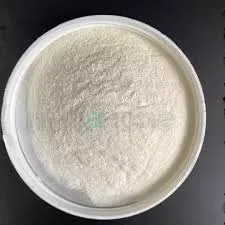
Sep . 23, 2024 12:26 Back to list
Applications of Hydroxypropyl Methylcellulose in Tablet Formulations and Their Benefits
The Versatile Role of Hydroxypropyl Methylcellulose in Tablet Formulations
Hydroxypropyl methylcellulose (HPMC) is a non-ionic, water-soluble polymer that has gained significant attention in the pharmaceutical industry, particularly in the formulation of tablets. Its unique properties and versatility make it an invaluable ingredient in drug formulation, offering benefits for both manufacturers and patients. This article explores the various uses of HPMC in tablet formulations and highlights the advantages it brings to the pharmaceutical table.
Overview of HPMC
Hydroxypropyl methylcellulose is derived from cellulose, a natural polymer found in plant cell walls. By modifying cellulose through the introduction of hydroxypropyl and methyl groups, HPMC is produced, enhancing its solubility and functionality. In tablet formulations, HPMC serves multiple roles, including as a binder, film-forming agent, and controlled release enhancer.
Binding Properties
One of the primary uses of HPMC in tablet formulations is its function as a binder. In tablet manufacturing, binders are essential for agglomerating the powdered ingredients, ensuring the final tablet has the necessary mechanical strength and integrity. HPMC's excellent binding properties facilitate the formation of strong bonds between the granules, resulting in tablets that can withstand mechanical stress during handling and transportation.
Moreover, HPMC exhibits a good balance of adhesion and plasticity, contributing to the production of tablets that disintegrate effectively when in contact with moisture. This is particularly important for oral dosage forms, as the rapid disintegration and dissolution of the tablet help in the quick absorption of the active pharmaceutical ingredient (API) in the gastrointestinal tract.
Film-Coating Agent
Another critical application of HPMC is its use as a film-coating agent. HPMC can form a transparent, flexible, and stable film on the surface of tablets, protecting them from external factors such as moisture and light. This film-coating is not only functional but also enhances the aesthetic appeal of the tablets, making them more attractive to consumers.
hydroxypropyl methylcellulose uses in tablets

Furthermore, film-coated tablets can mask unpleasant tastes or odors of certain APIs, improving patient compliance. HPMC's film-forming capabilities are essential for achieving uniform coatings and ensuring that the release profile of the drug is consistent, which is crucial for therapeutic efficacy.
Controlled Release Applications
HPMC plays a significant role in developing controlled-release formulations. By manipulating the concentration and molecular weight of HPMC in the tablet matrix, formulators can achieve specific release profiles tailored to the drug's pharmacokinetics. Controlled release not only helps maintain therapeutic levels of the drug in the bloodstream but also reduces the frequency of dosing, improving patient adherence to medication regimens.
For instance, HPMC-based matrices can be designed to swell and form a gel-like layer upon contact with gastrointestinal fluids. This gel layer acts as a barrier, regulating the diffusion of the drug from the tablet over an extended period. This property is particularly advantageous for drugs with a short half-life or those that require a sustained release to manage chronic conditions effectively.
Compatibility and Safety
One of the advantages of HPMC in tablet formulations is its compatibility with a wide range of APIs and excipients. This compatibility allows formulators to create stable, effective, and robust tablet formulations without compromising the integrity of the active ingredients. Additionally, HPMC is generally recognized as safe (GRAS) by regulatory agencies, making it an ideal choice for pharmaceutical applications.
Conclusion
Hydroxypropyl methylcellulose is a multifunctional excipient that plays a pivotal role in tablet formulations within the pharmaceutical industry. From serving as a binder to enhancing film-coating properties and enabling controlled-release mechanisms, HPMC proves to be an essential component in developing high-quality therapeutic products. Its compatibility, safety, and versatility make it a favored choice among formulators seeking to optimize tablet formulations while ensuring patient satisfaction and compliance. As the pharmaceutical landscape continues to evolve, the relevance of HPMC in drug delivery systems will likely expand, paving the way for innovative therapeutic solutions.
-
Versatile Hpmc Uses in Different Industries
NewsJun.19,2025
-
Redispersible Powder's Role in Enhancing Durability of Construction Products
NewsJun.19,2025
-
Hydroxyethyl Cellulose Applications Driving Green Industrial Processes
NewsJun.19,2025
-
Exploring Different Redispersible Polymer Powder
NewsJun.19,2025
-
Choosing the Right Mortar Bonding Agent
NewsJun.19,2025
-
Applications and Significance of China Hpmc in Modern Industries
NewsJun.19,2025







